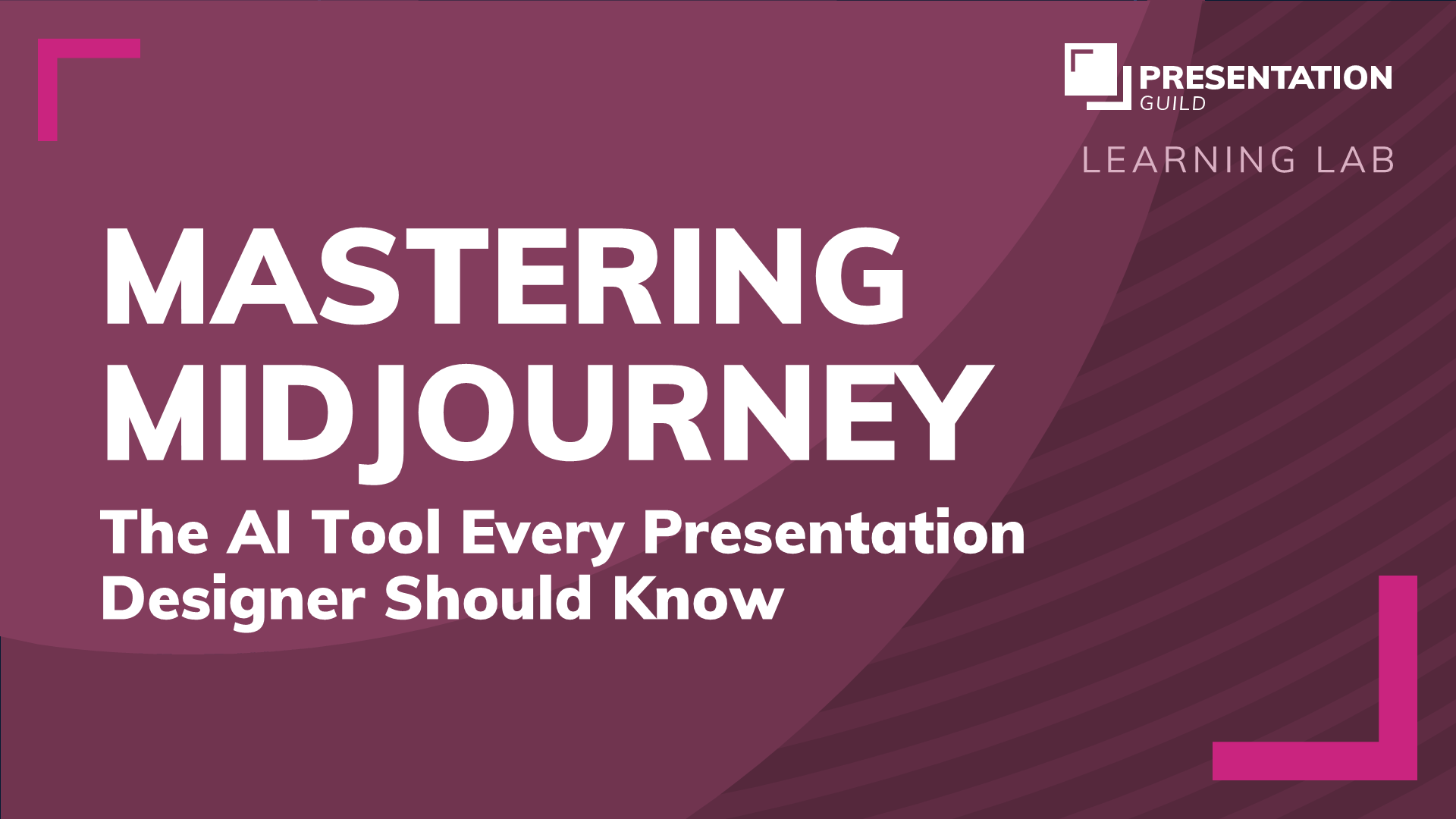The Presentation Guild Quarterly Presentations & AIs Series:
Mastering Midjourney for Presentation Design
Artificial intelligence is rapidly reshaping the way presentations are created and delivered. Among the most powerful tools for presentation designers today is Midjourney, an AI image-generation platform that produces high-quality, on-brand visuals with remarkable speed. To help presentation professionals understand how to integrate Midjourney into their workflow, Camille Holden (Co-Founder of Nuts & Bolts Speed Training) and Amy Balliett (Visual Strategy Expert, Author, and Senior Fellow of Visual Strategy at Material) recently shared their insights on how this tool can transform the design process.
Why Midjourney Stands Out
While AI image generators like DALL·E, Stable Diffusion, and Adobe Firefly all have their strengths, Amy Balliett emphasized Midjourney’s singular focus: image generation only. By concentrating its development efforts, Midjourney consistently rolls out improvements, with each update producing cleaner, more realistic, and more versatile results.
For presentation professionals, this matters. What used to take a week of sourcing stock photos or commissioning illustrations can now be completed in hours. Decks feel more cohesive, metaphors are easier to visualize, and consistency across slides is easier to maintain.
Writing Prompts That Deliver
One of the most important skills in Midjourney is prompt writing. Key principles include:
- Precision matters: Instead of vague terms (“a lot of dogs”), specify exact quantities (“three dogs” or “a herd of sheep”).
- Short vs. long prompts: Short prompts encourage creative outputs, while long prompts yield more precise control when you know exactly what you need.
- Add environmental cues: Lighting, color, and mood keywords can unify a series of images.
- Be literal: Replace abstract phrases with clear, descriptive language to reduce ambiguity.
“The best Midjourney users don’t get it right on the first prompt. Iteration is part of the process.” – Amy Balliett
Maintaining Consistency Across Decks
Consistency is often a pain point for presentation designers. Midjourney offers three features to keep visuals aligned:
- Style Reference: Apply the look of one image to new outputs.
- Character Reference: Keep a recurring subject consistent across multiple slides.
- Image Reference: Use an existing composition or layout to guide the AI’s design.
These tools allow a designer to maintain brand identity, narrative flow, and audience recognition without hours of manual editing.
Editing, Refining, and Finalizing
Beyond prompting, Midjourney includes powerful editing tools that make it practical for real-world presentation workflows:
- Pan & Zoom: Add whitespace to slides for text placement or reframe compositions.
- Upscale: Convert outputs into high-resolution, print-ready assets.
- Erase & Smart Select: Remove or replace elements with precision.
- Variations (Very Subtle / Very Strong): Explore new iterations without starting from scratch.
Together, these tools shift Midjourney from “experiment” to “production-ready,” giving presentation designers more control than traditional stock photo searches.
Rights and Responsible Use
While Midjourney empowers creativity, it also raises important legal and ethical considerations:
- The basic plan (listed at $10/month at the time of publishing) is sufficient for most presentation needs; Midjourney retains learning rights but not commercial control.
- The Mega plan grants full copyright ownership for those producing visuals for broader commercial use.
- Referencing specific artists or studios in prompts (e.g., “in the style of Disney”) should be avoided in commercial contexts.
- Uploaded brand assets remain private—ensuring client confidentiality is protected.
Looking Ahead
As Midjourney continues to evolve, so too will its role in professional presentation design. From faster iterations to greater creative freedom, AI tools are becoming integral to how decks are built. The challenge—and opportunity—for presentation professionals is to learn not just how to use these tools, but how to use them responsibly, creatively, and strategically.
Key Takeaways
- Midjourney is a leading AI image generator, evolving faster and more consistently than competitors.
- Effective prompts make all the difference—specific wording and quantified details improve results.
- References (style, character, image) ensure brand consistency across decks.
- Edit functions such as Pan, Zoom, Upscale, and Erase give designers practical control.
- The basic Midjourney plan is sufficient for most presentation uses (price accurate at time of publishing), but commercial projects may require higher tiers.
- Adobe Firefly is a strong alternative for those who prioritize copyright ownership and tighter brand control.
The Presentation Guild provides a space where these conversations happen, offering certification programs, live events, and a vibrant community of peers. If you're a member - don’t miss the next Presentation Guild Quarterly Business Talk session! Check out Events pages for the next one!
👉 Not yet a member? This kind of professional insight is what you’ll gain as a Presentation Guild member. Join the Presentation Guild Today!
